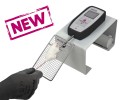Authors
J. J. Luszczki.
Lab
Medical University of Lublin Department of Pathophysiology and Institute of Agricultural Medicine Department of Physiopathology, Lublin, Poland.
Journal
Naunyn-Schmiedeberg's Archives of Pharmacology
Abstract
The aim of this study was to characterize the interaction between tiagabine (TGB) and ethosuximide (ETS), two antiepileptic drugs, in pentylenetetrazole (PTZ)-induced clonic seizures in mice using isobolographic analysis. The nature of the interaction between the drugs administered in combination was ascertained by estimating plasma and brain concentrations of ETS and TGB using fluorescence polarization immunoassay (FPIA) and high-performance liquid chromatography (HPLC). The results indicated that both drugs produced clear anticonvulsant effects against PTZ-induced clonic seizures in mice, but that their dose-response relationship curves (DRRCs) were not parallel, consequently necessitating the isobolographic analysis for non-parallel DRRCs. The isobolographic analysis revealed that the combination of TGB with ETS at the fixed-ratio of 1:1 exerted an additive interaction against PTZ-induced clonic seizures in mice. FPIA documented that TGB significantly elevated brain ETS concentrations (by 64%), while having no effect on plasma ETS concentrations in experimental animals. In contrast, ETS had no significant impact on plasma and brain concentrations of TGB in mice, as measured by HPLC. It can be concluded that the additive interaction between TGB and ETS at the fixed-ratio of 1:1 in the PTZ test was complicated by a significant pharmacokinetic increase in total brain ETS concentrations. At present, there are no recommendations to use this drug combination in epileptic patients.
BIOSEB Instruments Used:
Grip strength test (BIO-GS3)

 Douleur - Allodynie/Hyperalgésie Thermique
Douleur - Allodynie/Hyperalgésie Thermique Douleur - Spontanée - Déficit de Posture
Douleur - Spontanée - Déficit de Posture Douleur - Allodynie/Hyperalgésie Mécanique
Douleur - Allodynie/Hyperalgésie Mécanique Apprentissage/Mémoire - Attention - Addiction
Apprentissage/Mémoire - Attention - Addiction Physiologie & Recherche Respiratoire
Physiologie & Recherche Respiratoire
 Douleur
Douleur Système Nerveux Central (SNC)
Système Nerveux Central (SNC)  Neurodégénérescence
Neurodégénérescence Système sensoriel
Système sensoriel Système moteur
Système moteur Troubles de l'humeur
Troubles de l'humeur Autres pathologies
Autres pathologies Système musculaire
Système musculaire Articulations
Articulations Métabolisme
Métabolisme Thématiques transversales
Thématiques transversales Congrès & Meetings
Congrès & Meetings 